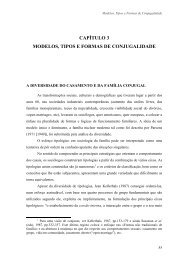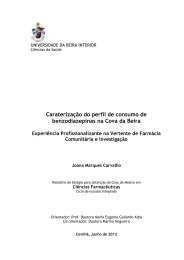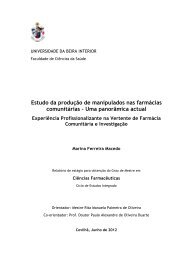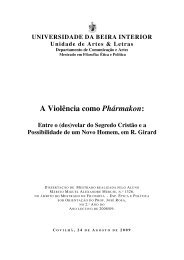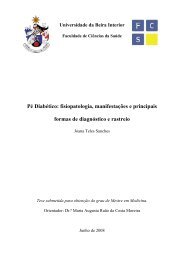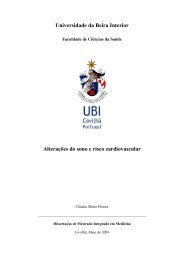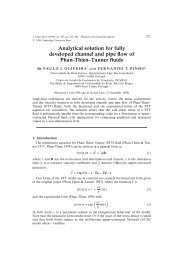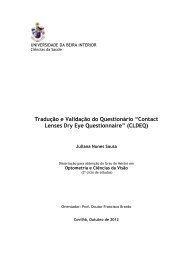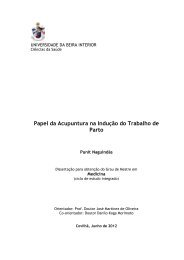Tese_Tânia Vieira.pdf - Ubi Thesis
Tese_Tânia Vieira.pdf - Ubi Thesis
Tese_Tânia Vieira.pdf - Ubi Thesis
Create successful ePaper yourself
Turn your PDF publications into a flip-book with our unique Google optimized e-Paper software.
Chapter I - Introduction<br />
century (Rai et al. 2009). In 1990s, silver was introduced in a colloidal form (i.e. AgNPs) in<br />
ointments that could be applied to open wounds, in order to kill bacteria (Arora et al. 2008).<br />
Recently, due to the emergence of antibiotic-resistant bacteria and limitations associated with<br />
the use of these medicines, doctors have restarted to use silver, mainly in the form of AgNPs in<br />
order to fight different types of infections affecting humans (Rai et al. 2009).<br />
AgNPs are nano-sized structures formed from silver atoms that are metallically bonded<br />
together and have a size from approximately 1 nm to 100 nm (Chaloupka et al. 2010; Songsilawat<br />
et al. 2010). It has been shown that they can be used in medicine and health-related areas<br />
(Cumberland et al. 2009), due to their interesting optical and catalytic properties, high<br />
resistance to oxidation and high thermal conductivity (Vertelov et al. 2008; Wong et al. 2009;<br />
Prucek et al. 2011). Furthermore, their tunable size, shape and surface chemistry allow them to<br />
be designed with specific properties that are critical for several applications (Potara et al.<br />
2011), most typically antimicrobial and sterile applications (Marambio-Jones et al. 2010). Taking<br />
into account the antibacterial activity of silver, it is better for AgNPs than for other silver forms,<br />
as bulk silver (Potara et al. 2011; Xu et al. 2011), silver ions (Ag + ) and other silver salts (Li et al.<br />
2011), even when applied in lower concentrations (da Silva Paula et al. 2009; Domingos et al.<br />
2011). The higher antibacterial activity is due to high specific surface area and high fraction of<br />
surface atoms (more than 1000 atoms in one 5 nm particle (Vertelov et al. 2008)) in AgNPs (da<br />
Silva Paula et al. 2009), which allows a better contact with microorganisms (Ghosh et al. 2010;<br />
Juan et al. 2010; Li et al. 2010; Guzman et al. 2011). Therefore, smaller-sized particles with<br />
1/1000 of the bacterium size (since AgNPs have a nanometer size and bacteria a micrometer<br />
size) show stronger antibacterial activity (Guzman et al. 2011; Kurek et al. 2011; Shameli et al.<br />
2011). Furthermore, the nanoparticles release Ag + in aqueous solutions, which enhance their<br />
bactericidal activity (da Silva Paula et al. 2009; Chaloupka et al. 2010; Juan et al. 2010).<br />
AgNPs due their antimicrobial properties, are capable of kill several microorganisms<br />
responsible for 650 types of different diseases (Raffi et al. 2008). These nanoparticles have<br />
revealed bactericidal activity against as many as 16 bacteria species (Sondi et al. 2004) either<br />
gram-positive or gram-negative (Monteiro et al. 2009; Sheikh et al. 2010), including Escherichia<br />
coli (E. coli), Staphylococcus aureus (S. aureus), Bacillus subtilis, Streptococcus mutans,<br />
Staphylococcus epidermidis (Li et al. 2011) and highly multiresistant strains such as methicillinresistant<br />
S. aureus (Fayaz et al. 2010). Moreover, they also showed antifungal activity<br />
(Kacarevic-Popovic et al. 2007; Häntzschel et al. 2009; Monteiro et al. 2009) against Candida<br />
albicans, Candida glabrata, Candida parapsilosis, Candida krusei, and Trichophyton<br />
mentagrophytes (Li et al. 2011). More recently, it has also been reported that AgNPs can<br />
inactivate virus (Kacarevic-Popovic et al. 2007; Monteiro et al. 2009; Li et al. 2010) like hepatitis<br />
B virus, herpes simplex, monkeypox, respiratory syncytial virus (Li et al. 2011), and also exhibit<br />
antiviral properties against HIV infected cells (Panác ek et al. 2006; Shameli et al. 2010; Shameli<br />
et al. 2011), via preferential binding of the AgNPs to the gp120 glycoprotein knobs through the<br />
sulfur-bearing residues of glycoprotein amino acids, thus inhibiting the virus from binding to the<br />
target cell membrane receptor (Thomas et al. 2007).<br />
8




